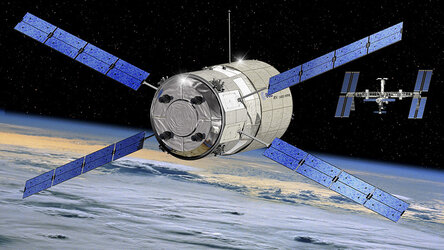ESA tracks Ariane and ATV Johannes Kepler
Two ESA ground stations in Europe and Australia will provide crucial tracking support for the flight of Ariane 5, set for liftoff on 15 February with ATV-2 .Three more stations plus a central control team will stand by to provide back-up telecommanding during ATV's mission.
When Johannes Kepler, Europe's second Automated Transfer Vehicle (ATV), lifts-off 15 February on Ariane, ground stations from ESA's worldwide ESTRACK network will provide support in two crucial areas.
First, they will track Ariane through its two orbits of Earth, receiving real-time flight data. Next, once ATV is in orbit, the network will take on a new role, providing back-up communication and telecommanding links between ATV in space and ESA's ATV Control Centre (ATV-CC) in Toulouse, France.
This won't be the first time that ESTRACK stations have followed an Ariane flight. ESA's 5.5 m-diameter Santa Maria station, in the Azores, tracked Ariane V181 during the 2008 launch of ATV Jules Verne. The 15 m antenna at Perth, Western Australia, tracked an Ariane 5 launch in 2009. However, this time, the two stations will track Ariane together.
Stations provide double support on launch day

On launch day, set for 15 February, Santa Maria will pick up telemetry signals once again as Ariane soars some 130 km overhead just 12 minutes after liftoff from Kourou, in French Guiana. This will be repeated during Ariane's second loop around Earth, about 93 minutes later, at an altitude of about 250 km. Perth will acquire data starting 144 minutes after liftoff during the launcher's second and final orbit.

The stations will receive crucial telemetry data containing up-to-the-second information on Ariane's systems such as propulsion, guidance and navigation.
"The team and equipment at Santa Maria performed flawlessly in 2008 and we have now added Perth," said Gerhard Billig, lead engineer responsible for launcher tracking at ESOC, ESA's European Space Operations Centre.
"Both stations have undergone extensive testing and simulations plus a full operational test in January. We are ready for next week's Ariane flight and anticipate excellent results."
ESTRACK stations: critical back-up link to ATV in orbit
Once ATV has been delivered into orbit at about 350 km altitude, the ESTRACK network will be on call to provide critical back-up telecommunications as Johannes Kepler manoeuvres to its docking with the International Space Station (ISS), planned for 23 February.
When ATV is in free flight after launch and before reentry, European mission controllers at ATV-CC normally send commands to it via NASA's Tracking and Data Relay Satellite System, a constellation of relay satellites that provide full-time links to the ISS. A second channel is provided by ESA's own Artemis, which is used primarily when ATV is attached to the ISS.

For Johannes Kepler and future ATV missions, if any problems occur with the data relay channels, a third back-up communication channel can now be provided by the ESTRACK network.
Dubbed 'Proximity Back-up Communications', it makes use of the existing proximity radio on ATV, which is usually used to communicate directly with the ISS over a distance of just a few kilometres (hence 'proximity').
For telecommanding from the ground, the ATV radio is switched into a special mode that allows it to send and receive signals directly to Earth, 'talking' with stations at Maspalomas or ESA/ESAC (European Space Astronomy Centre), Spain, or Redu, Belgium. From these stations, data are routed via the ESTRACK Control Centre at ESOC, in Germany, to ATV-CC in Toulouse.
Expanding ESTRACK's capabilities

The capability to command ATV via ESTRACK existed with ATV Jules Verne in 2008, but only from a single station, Redu. The improvement to include additional stations, and thus expand the amount of coverage time during each orbit, makes further use of ESA's own networks and facilities.
"The project required team work and engineering innovation," said ESA's Fabio Sintoni, ground segment engineer at ATV-CC.

"We had to further develop this third communication link without altering the proven design of ATV communication systems and within the capabilities of the current ground stations. It's an ingenious, 'made in Europe' solution."
The new link has been tested extensively. Most recently, on 28 January, the network received live over-the-air radio data from ATV Johannes Kepler mounted on top of its Ariane launcher via ESA's 15 m antenna in Kourou – just a few kilometres away, proving that ATV communicate with ESTRACK.

"In addition to its usual role of providing telecommand links for ESA and partner missions anywhere from low Earth orbit to deep space, millions of kilometres away at Mars or Venus, the ESTRACK network is proving to be a valuable and reliable resource for human spaceflight missions," said Erik Soerensen, ESA's Head of the Ground Facilities External Services at ESOC.















 Germany
Germany
 Austria
Austria
 Belgium
Belgium
 Denmark
Denmark
 Spain
Spain
 Estonia
Estonia
 Finland
Finland
 France
France
 Greece
Greece
 Hungary
Hungary
 Ireland
Ireland
 Italy
Italy
 Luxembourg
Luxembourg
 Norway
Norway
 The Netherlands
The Netherlands
 Poland
Poland
 Portugal
Portugal
 Czechia
Czechia
 Romania
Romania
 United Kingdom
United Kingdom
 Slovenia
Slovenia
 Sweden
Sweden
 Switzerland
Switzerland

































